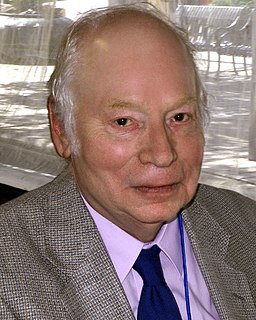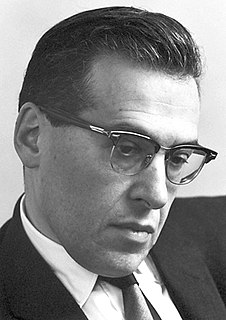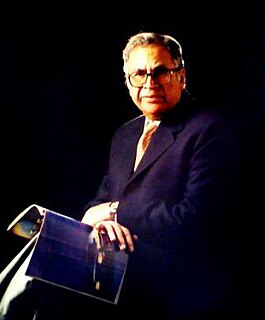
In particle physics, the electroweak interaction or electroweak force is the unified description of two of the four known fundamental interactions of nature: electromagnetism and the weak interaction. Although these two forces appear very different at everyday low energies, the theory models them as two different aspects of the same force. Above the unification energy, on the order of 246 GeV, they would merge into a single force. Thus, if the universe is hot enough (approximately 1015 K, a temperature not believed to have been exceeded since shortly after the Big Bang), then the electromagnetic force and weak force merge into a combined electroweak force. During the quark epoch, the electroweak force split into the electromagnetic and weak force. (For comparison, the current hottest man-made temperature is slightly higher than 1012 K.)

In theoretical physics, quantum chromodynamics (QCD) is the theory of the strong interaction between quarks mediated by gluons. Quarks are fundamental particles that make up composite hadrons such as the proton, neutron and pion. QCD is a type of quantum field theory called a non-abelian gauge theory, with symmetry group SU(3). The QCD analog of electric charge is a property called color. Gluons are the force carriers of the theory, just as photons are for the electromagnetic force in quantum electrodynamics. The theory is an important part of the Standard Model of particle physics. A large body of experimental evidence for QCD has been gathered over the years.

In particle physics, quantum electrodynamics (QED) is the relativistic quantum field theory of electrodynamics. In essence, it describes how light and matter interact and is the first theory where full agreement between quantum mechanics and special relativity is achieved. QED mathematically describes all phenomena involving electrically charged particles interacting by means of exchange of photons and represents the quantum counterpart of classical electromagnetism giving a complete account of matter and light interaction.

The Standard Model of particle physics is the theory describing three of the four known fundamental forces excluding gravity in the universe and classifying all known elementary particles. It was developed in stages throughout the latter half of the 20th century, through the work of many scientists worldwide, with the current formulation being finalized in the mid-1970s upon experimental confirmation of the existence of quarks. Since then, proof of the top quark (1995), the tau neutrino (2000), and the Higgs boson (2012) have added further credence to the Standard Model. In addition, the Standard Model has predicted various properties of weak neutral currents and the W and Z bosons with great accuracy.

Steven Weinberg was an American theoretical physicist and Nobel laureate in physics for his contributions with Abdus Salam and Sheldon Glashow to the unification of the weak force and electromagnetic interaction between elementary particles.

Julian Seymour Schwinger was a Nobel Prize winning American theoretical physicist. He is best known for his work on quantum electrodynamics (QED), in particular for developing a relativistically invariant perturbation theory, and for renormalizing QED to one loop order. Schwinger was a physics professor at several universities.

In the Standard Model of particle physics, the Higgs mechanism is essential to explain the generation mechanism of the property "mass" for gauge bosons. Without the Higgs mechanism, all bosons (one of the two classes of particles, the other being fermions) would be considered massless, but measurements show that the W+, W−, and Z0 bosons actually have relatively large masses of around 80 GeV/c2. The Higgs field resolves this conundrum. The simplest description of the mechanism adds a quantum field (the Higgs field) that permeates all Hilbert spaces of the Standard Model. Below some extremely high temperature, the field causes spontaneous symmetry breaking during interactions. The breaking of symmetry triggers the Higgs mechanism, causing the bosons it interacts with to have mass. In the Standard Model, the phrase "Higgs mechanism" refers specifically to the generation of masses for the W±, and Z weak gauge bosons through electroweak symmetry breaking. The Large Hadron Collider at CERN announced results consistent with the Higgs particle on 14 March 2013, making it extremely likely that the field, or one like it, exists, and explaining how the Higgs mechanism takes place in nature. The view of the Higgs mechanism as involving spontaneous symmetry breaking of a gauge symmetry is technically incorrect since by Elitzur's theorem gauge symmetries can never be spontaneously broken. Rather, the Fröhlich–Morchio–Strocchi mechanism reformulates the Higgs mechanism in an entirely gauge invariant way, generally leading to the same results.

Sidney Richard Coleman was an American theoretical physicist noted for his research in high-energy theoretical physics.
The Alternative models to the Standard Higgs Model are models which are considered by many particle physicists to solve some of the Higgs boson's existing problems. Two of the most currently researched models are quantum triviality, and Higgs hierarchy problem.

In particle physics, the history of quantum field theory starts with its creation by Paul Dirac, when he attempted to quantize the electromagnetic field in the late 1920s. Heisenberg was awarded the 1932 Nobel Prize in Physics "for the creation of quantum mechanics". Major advances in the theory were made in the 1940s and 1950s, leading to the introduction of renormalized quantum electrodynamics (QED). QED was so successful and accurately predictive that efforts were made to apply the same basic concepts for the other forces of nature. By the late 1970s, these efforts successfully utilized gauge theory in the strong nuclear force and weak nuclear force, producing the modern Standard Model of particle physics.

John Clive Ward, was a British-Australian physicist. He introduced the Ward–Takahashi identity, also known as "Ward Identity". Andrei Sakharov said Ward was one of the titans of quantum electrodynamics. He made significant contributions to quantum solid-state physics, statistical mechanics and the Ising model.
Erick J. Weinberg is a theoretical physicist and professor of physics at Columbia University.
In theoretical physics, thermal quantum field theory or finite temperature field theory is a set of methods to calculate expectation values of physical observables of a quantum field theory at finite temperature.
The timeline of particle physics lists the sequence of particle physics theories and discoveries in chronological order. The most modern developments follow the scientific development of the discipline of particle physics.

John (Jean) Iliopoulos is a Greek physicist. He is the first person to present the Standard Model of particle physics in a single report. He is best known for his prediction of the charm quark with Sheldon Glashow and Luciano Maiani. Iliopoulos is also known for demonstrating the cancellation of anomalies in the Standard model. He is further known for the Fayet-Iliopoulos D-term formula, which was introduced in 1974. He is currently an honorary member of Laboratory of theoretical physics of École Normale Supérieure, Paris.

Riazuddin, also spelled as Riaz-Ud-Din, was a Pakistani theoretical physicist, specialising in high-energy physics and nuclear physics. Starting his scientific research in physics in 1958, Riazuddin was considered one of the early pioneers of Pakistan's nuclear weapons development and atomic deterrence development. He was the director of the Theoretical Physics Group (TPG) of the Pakistan Atomic Energy Commission (PAEC) from 1974 until 1984. Riazuddin was a pupil of the winner of the 1979 Nobel Prize in Physics, Abdus Salam.
The 1964 PRL symmetry breaking papers were written by three teams who proposed related but different approaches to explain how mass could arise in local gauge theories. These three papers were written by: Robert Brout and François Englert; Peter Higgs; and Gerald Guralnik, C. Richard Hagen, and Tom Kibble (GHK). They are credited with the theory of the Higgs mechanism and the prediction of the Higgs field and Higgs boson. Together, these provide a theoretical means by which Goldstone's theorem can be avoided. They show how gauge bosons can acquire non-zero masses as a result of spontaneous symmetry breaking within gauge invariant models of the universe.
In theoretical physics, a mass generation mechanism is a theory that describes the origin of mass from the most fundamental laws of physics. Physicists have proposed a number of models that advocate different views of the origin of mass. The problem is complicated because the primary role of mass is to mediate gravitational interaction between bodies, and no theory of gravitational interaction reconciles with the currently popular Standard Model of particle physics.
Laurie Mark Brown is an American theoretical physicist and historian of quantum field theory and elementary particle physics.

In quantum electrodynamics, Furry's theorem states that if a Feynman diagram consists of a closed loop of fermion lines connected to an odd number of vertices, its contribution vanishes. As a corollary, no single photon can arise or be destroyed from the vacuum state. The theorem was first derived by Wendell H. Furry in 1937, as a direct consequence of the conservation of energy and charge conjugation symmetry.









